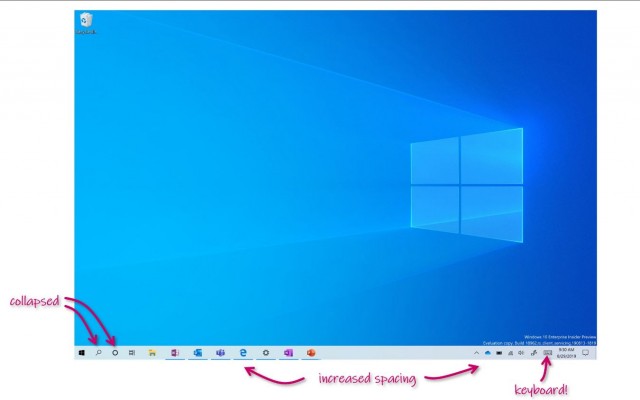Microsoft Just Made Windows 10 Way Better for 2-in-1 Laptops
Windows 10's tablet mode is about to get a major overhaul.
Microsoft is testing a new interface for the touch-friendly tablet mode enabled on 2-in-1 laptops and detachables, like the HP Spectre x360 and Surface Pro 6. Gone is the tiled interface and in its place is a new home screen that looks very similar to the current desktop design.
Microsoft explained in a blog post that the new interface would let users switch from laptop to tablet mode while keeping the familiar desktop aesthetic. Switching between modes should be faster and more cohesive, and you'll no longer be asked whether you want to enter tablet mode.
While the new tablet mode looks identical to the current desktop design at first glance, a few key changes were made to optimize for touch. To start, wider spacing on the taskbar should make it easier to select icons with your fingers or a stylus. Additionally, the large search bar in the bottom-left corner of desktop mode will collapse into a smaller icon in the new tablet mode, and the File Explorer transforms into a touch-optimized layout. Lastly, an icon that pulls up the on-screen keyboard will appear in the bottom-right corner whenever a text field is selected.
"Instead of turning on Tablet Mode when you switch a 2-in-1 PC into a tablet posture, this just turns on key touch improvements, but keeps with the familiar desktop experience," Microsoft program manager Brandon LeBlanc wrote in a tweet.
The current tablet mode is a relic of the Windows 8 interface. As it stands, when you flip a 2-in-1 convertible or undock a detachable, your PC's interface switches from the standard desktop to a touch-optimized layout wherein the Start menu expands to fill the home page with large tiles and the taskbar vanishes altogether. Because they're so different, switching between the two modes can feel clunky and it can be hard to pick up where you left off.
The redesign is specifically for 2-in-1 devices, so non-detachable Windows 10 tablets will keep the current Windows 10 tablet mode experience. And as PCMag reports, the existing tablet mode will remain on Windows 10 but will be disabled by default when the changes roll out.
Sign up to receive The Snapshot, a free special dispatch from Laptop Mag, in your inbox.
But that might not be for a while. Microsoft is currently testing the new tablet mode in beta on a handful of Windows Insiders, so expect a number of changes to be made between now and launch.
Phillip Tracy is the assistant managing editor at Laptop Mag where he reviews laptops, phones and other gadgets while covering the latest industry news. After graduating with a journalism degree from the University of Texas at Austin, Phillip became a tech reporter at the Daily Dot. There, he wrote reviews for a range of gadgets and covered everything from social media trends to cybersecurity. Prior to that, he wrote for RCR Wireless News covering 5G and IoT. When he's not tinkering with devices, you can find Phillip playing video games, reading, traveling or watching soccer.


